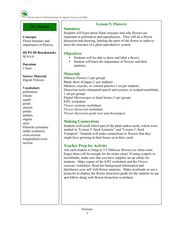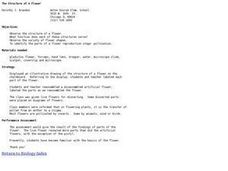Garden Earth Naturalist Club
Parts of a Flower! Flower Dissection
Sometimes the best way to learn about plants is to see the different parts of a plant yourself. Groups of learners dissect flowers to answer questions about what they observe and what they wonder about their flower.
Curated OER
Flower Reproduction
Fifth graders examine the cycle of flower reproduction. They listen to a poem about a bee, observe and examine flowers in small groups, and develop a class KWL chart. Students then read about flower reproduction in their textbook, and...
Curated OER
Flower Dissection
Beginning biologists pull a flower apart and familiarize themselves with the different reproductive structures. Why have them learn only from just a book or diagram when they can examine real samples? There is no link to the referenced...
Curated OER
Flower Dissection
Students dissect three different flowers and compare and contrast them. In this flowers lesson plan, students learn about the flower anatomy and then dissect their own flowers.
Curated OER
Dry Forest: Flowers
Students explore botany by examining diagrams. In this plant reproduction lesson plan, students define a list of plant vocabulary terms and identify plant anatomy from a diagram. Students complete several plant activity worksheets and...
Curated OER
The Blossoming of Flower Power
Learners explore the reproductive functions of flowers by participating in a flower dissection lab.
Curated OER
Pollination-Plants and Flowers Lesson Plan
Students study the reproductive parts and pollination for a flower. In this pollination lesson plan, students dissect flowers to perform an investigation. Students also use tube socks to show how pollination works. A diagram is included.
Curated OER
The Structure of A Flower
Students study the structure of flowers. In this biology lesson plan, students observe the structure of a flower and find out what function each of the structures serve.
Curated OER
From Flower to Fruit
Students examine how flowers have essentially four parts. They learn both the male and female reproductive parts of the flower, then explore self-pollination and pollination by insects and other animals.
Curated OER
Plant Pollination
Learners investigate methods of pollination for various flowers. In this plant biology lesson, students learn the parts of a flower and form a hypothesis about the method of pollination for the flower. They determine the validity of...
Curated OER
The Angiosperms
Students study angiosperms and their classifications. For this investigative lesson students compare the sexual reproduction of angiosperms and seed formations.
Curated OER
Pollination
Students investigate pollination. In this plant biology lesson plan, students study a diagram of the reproductive parts of the flower and dissect and identify the parts of a real flower.
Curated OER
Pollination Station
Students investigate why and how bees pollinate flowers and other plants. They define pollination, and read and sing along with the song "Yo, i'm a Flower." Students examine a diagram of a flower, simulate bees pollinating flowers, and...
Curated OER
Pollination
Third graders discuss pollination and how bees pollinate flowers. In this pollination lesson plan, 3rd graders draw the pollination process on a piece of paper.
Curated OER
Structure and Function of Bulbs, Corms and Rhizomes
Students explore the concept of philanthropy and why people give. They investigate the importance of the tulip to Holland and the tradition of giving flowers away. They begin to explore the life cycle of tulips and dissect a bulb to...
Curated OER
Plant Pollution
Learners study the different parts of a flower and their functions. For this pollination lesson students study a flower under a microscope.
Curated OER
Plant Pollination and Fertilization
Fourth graders research and apply knowledge about plant pollination and fertilization in this lesson. They color on a flower diagram the anther, the pistil, the pollen, the pollen tube, the ovary, and the egg to show the process of...
Curated OER
Life Cycle of Brassica Plants: Planting Seeds
Learners explore botany by participating in a calendar class activity. In this plant observation lesson, students examine a diagram of a Brassica plant and identify its anatomy before planting their own seeds and viewing the changes over...
Virginia Department of Education
Animal Phyla and Plant Divisions
Searched hours for an activity that allows individuals the ability to use multiple resources to learn about both plant and animal kingdoms? This discussion and activity provide pupils with the ability to visualize each organism before...
Curated OER
Eat Your Plants
Students explore fruits and vegetables. In this fruits and vegetables lesson, students work in small groups investigating plant parts. Students discover that fruits and vegetables originate from different parts of plants.
Curated OER
Window Gardens
High schoolers use a plastic sandwich bag containing a damp paper towel taped to a window as a model system to observe the germination and early growth of radish seeds. They are challenged to pose a question about seed germination and...
Curated OER
Mitosis and Meiosis
Students model and differentiate between the processes of mitosis and meiosis. In partners, they use yarn and construction paper to create models for each of the phases of mitosis and meiosis then compare the chromosome numbers in each...























